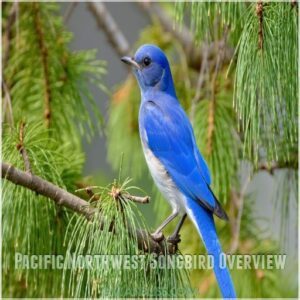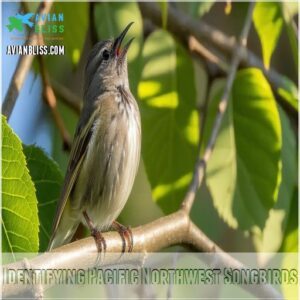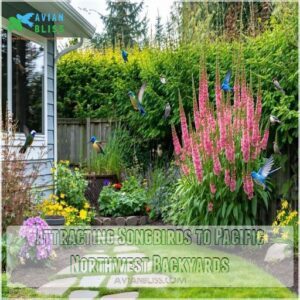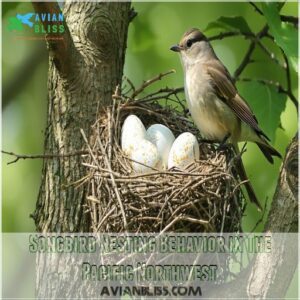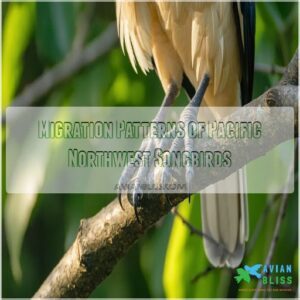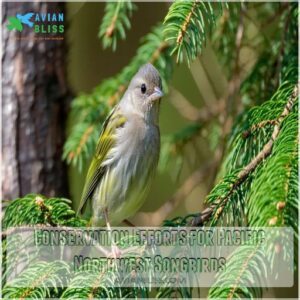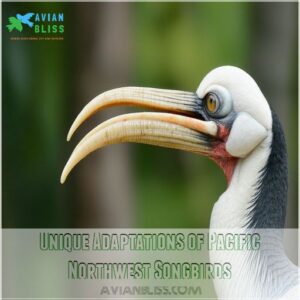This site is supported by our readers. We may earn a commission, at no cost to you, if you purchase through links.
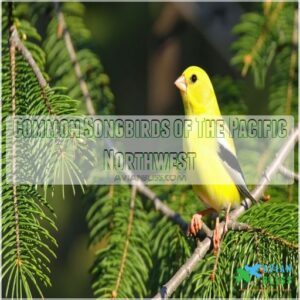
These feathered neighbors include year-round residents like American Robins and Dark-eyed Juncos, along with seasonal visitors such as Western Tanagers.
Each species brings its own unique song to the region’s natural symphony.
In your backyard, you might spot Spotted Towhees scratching through leaves or American Goldfinches brightening up your feeders.
While some birds, like House Finches, prefer urban settings, others thrive in the region’s diverse forests and wetlands.
Their distinctive behaviors and habitat preferences, including those of the White-crowned Sparrow, which faces population decline due to habitat loss and climate change, tell a fascinating story of adaptation.
Table Of Contents
- Key Takeaways
- Pacific Northwest Songbird Overview
- Common Songbirds of The Pacific Northwest
- Identifying Pacific Northwest Songbirds
- Songbird Feeding Habits in The Pacific Northwest
- Attracting Songbirds to Pacific Northwest Backyards
- Songbird Nesting Behavior in The Pacific Northwest
- Migration Patterns of Pacific Northwest Songbirds
- Threats to Pacific Northwest Songbirds
- Conservation Efforts for Pacific Northwest Songbirds
- Unique Adaptations of Pacific Northwest Songbirds
- Frequently Asked Questions (FAQs)
- Are there hummingbirds in the Pacific Northwest?
- How do you know if a songbird is a bird?
- Where should you go birdwatching in the northwest?
- What are the yellow and red birds in the Pacific Northwest?
- What are the yellow birds in the Puget Sound?
- What is the Pacific Northwest white bird?
- What is the best bird feed for the Pacific Northwest?
- How long do Pacific Northwest songbirds typically live?
- What diseases commonly affect backyard songbird populations?
- Can songbirds recognize individual human faces?
- Do urban noise levels affect songbird breeding success?
- Which songbird species are expanding their range northward?
- Conclusion
Key Takeaways
- You’ll find an incredible variety of songbirds in the Pacific Northwest, including year-round residents like American Robins and Dark-eyed Juncos, alongside seasonal visitors such as Western Tanagers.
- You can attract songbirds to your backyard by providing native vegetation for shelter, installing water sources, and offering appropriate nesting materials.
- You’ll notice distinct feeding habits among different species – while some prefer seeds at feeders, others hunt insects or forage for berries, making diverse food sources essential.
- You can help protect these birds from threats like habitat loss and climate change by participating in local conservation efforts and citizen science programs.
Pacific Northwest Songbird Overview
You’ll find a rainbow of songbirds fluttering through the Pacific Northwest, from the cheerful American Robin to the lively Black-capped Chickadee.
Each species brings its own quirks and charms, making every birdwatching trip an adventure in nature’s living orchestra.
Diverse Range of Species
The Pacific Northwest boasts incredible species diversity!
You’ll find a vibrant mix of songbirds, each perfectly adapted to its environment.
Let’s explore some of the common varieties:
To help you identify these feathered friends, consider using a helpful resource like a PNW bird guide.
pnw songbirds like the American Robin thrive in diverse habitats.
Common birds in the Pacific Northwest can be identified by their unique vocalizations, such as the complex bird song structure, pacific northwest include the cheerful Song Sparrow.
Bird identification pnw can be tricky, but rewarding!
Unique Characteristics and Charm
Spotting songbirds is like finding hidden gems, each with unique charm. Imagine putting on shorts and appreciating their calls marking their territory.
Songbird Traits Behaviors
Adaptations
—
Bird calls
Vocalizations
Bird songs
Bird diversity
Embrace their charm!
Common Songbirds of The Pacific Northwest
When you’re exploring the rich forests and open spaces of the Pacific Northwest, you’ll encounter some of the most charming songbirds like the American Robin and the Black-capped Chickadee.
Keep an eye out for the vibrant American Goldfinch and the sociable Dark-eyed Junco, whose cheerful tunes might just become the soundtrack to your outdoor adventures.
American Robin
Imagine stepping outside and hearing the cheery tunes of an American Robin.
This common songbird captivates with its bright orange-red breast and melodic calls, adding a splash of color to the Pacific Northwest.
With varied Robin song variations, they’re adaptable feeders enjoying insects and fruits.
Migration routes take them southward as seasons change, highlighting their versatile nature and important role in ecosystem balance.
Song Sparrow
Moving from robins, let’s chat about the song sparrow, a common bird of the Pacific Northwest.
These sparrows thrive in diverse habitats, showcasing their distinctive streaked plumage.
Recognized for their melodious vocalizations, they’re quick to charm any listener.
They munch on a varied diet, from seeds to insects, and their nests, hidden in shrubs, offer a snug retreat.
American Goldfinch
The American Goldfinch, one of the common songbirds in the Pacific Northwest, is a flickering splash of yellow during the breeding season.
They brighten up your backyard by visiting bird feeders in flocks, their diet variations ranging from seeds to insects.
Watch for their clever nest placement in trees.
In winter plumage, they trade summer brilliance for a subtler olive-brown.
Dark-eyed Junco
A familiar sight, the Dark-eyed Junco, often called the “snowbird,” flits through the Pacific Northwest.
This winter visitor boasts a slate-gray back and white belly.
To spot one:
- Look for them at ground feeders where they nibble seeds.
- Notice their distinct winter plumage.
- Recognize various Junco subspecies across different breeding ranges.
- Appreciate conservation efforts for these common birds.
Black-capped Chickadee
From the quiet charm of the Dark-eyed Junco, let’s hop over to another common sight: the Black-capped Chickadee.
These tiny fluffballs are masters of winter survival, their Chickadee memory astounding, often making them a staple in British Columbia’s winter birdwatching scene, especially during backyard birding.
They’re social birds, with a complex Chickadee social structure.
Listen for their distinctive Black-capped Chickadee calls—a cheerful "chick-a-dee-dee-dee!"—to identify them.
Their Chickadee nesting habits are fascinating, too.
Spotting one in your Pacific Northwest backyard is a real treat!
Identifying Pacific Northwest Songbirds
When you’re identifying Pacific Northwest songbirds, look for clues in their physical characteristics, such as size and shape, to help spot them in the wild.
Pay attention to the rich colors and unique beak shapes, which can range from the sleek curve of a hummingbird’s bill to the stout form of a sparrow’s beak—each is a little nature-made mystery waiting to be solved.
Physical Characteristics
To spot songbirds in the Pacific Northwest, notice their size and shape.
Birds have distinct beak shapes for eating: short, thick for seeds or long, slender for insects.
Wingspan helps them glide or flap through treetops.
Tail length can tell you about their agility.
Each bird species carries unique physical traits that aid in identification and behavior insights.
Coloration and Plumage Patterns
Spotting Pacific Northwest songbirds adds a splash of color to your day.
Understanding their color patterns and arrangement of light and dark areas is essential to quick identification.
Their plumage patterns and coloration shift with the seasons, like the Northern Cardinal’s bold reds or the American Goldfinch’s bright yellows.
These changes often involve plumage molting and adaptations, helping with mimicry and defense.
Keep your eyes peeled for these vibrant flashes during your backyard birdwatching.
Beak Shape and Size
Understanding beak adaptations in songbirds is like solving a puzzle of evolution.
Beak shapes and sizes are crafted by nature’s hand to suit specific food sources.
Think of the sleek bill of a hummingbird, perfect for nectar-sipping, versus the sturdy beak of a sparrow, built for seed-cracking.
These adaptations highlight each bird species’ unique feeding techniques and evolutionary pressures.
Songbird Feeding Habits in The Pacific Northwest
In the Pacific Northwest, songbirds have diverse feeding habits, munching on everything from seeds and insects to fruits and nectar.
You’ll likely spot them at various feeders, using unique techniques to nab their favorite snacks.
Preferred Food Types
You’ve got the knack for identifying songbirds, now let’s talk chow.
Their preferred food types dance with seasonal variations and nutritional needs.
Picture them savoring these delights:
- Seeds and grains, perfect for the picky palate.
- Berries and fruit, nature’s candy.
- Insects and larvae, a protein-packed treat.
Shift your garden’s buffet with bird-friendly plants and watch them flock in!
Feeder Preferences
Knowing what birds like to eat is only half the battle.
Next, you need to know how they like to eat it!
American Goldfinches, for example, prefer tube feeders with small perches, while Black-capped Chickadees will happily use almost any feeder type.
Seed preferences vary by season too.
So, experiment with different bird feeders and see what works best in your backyard!
DIY feeders can be fun, too.
Foraging Techniques
Think of Pacific Northwest songbirds as little foraging experts.
They’re often spotted hopping along the ground foraging for seeds or perch-gleaning for insects.
Some, like chickadees, are masters of seed-caching, storing food for leaner times, and will frequent bird feeders with suet.
Meanwhile, swift aerial hunters like the flycatchers snag insects mid-flight.
Understanding these techniques makes observing their feeding habits truly fascinating and rewarding.
Attracting Songbirds to Pacific Northwest Backyards
To transform your backyard into a vibrant haven for songbirds in the Pacific Northwest, focus on planting native vegetation, providing water sources, and offering nesting materials.
With a well-stocked buffet and cozy nesting spots, you’ll attract a chorus of cheerful birds ready to settle in and serenade you.
Planting Native Vegetation
Songbirds aren’t just fans of feeders; they’re drawn to yards filled with native vegetation.
Native plants offer natural food sources and shelter, creating a bird-friendly haven.
Choose wisely, and your garden will become a go-to escape for feathered friends.
- Native plant benefits: Enhance biodiversity and attract more species.
- Seed sourcing: Opt for locally sourced options.
- Seasonal plantings: Provide year-round interest and sustenance.
Providing Water Sources
Everyone knows a splash of water can turn a backyard into a bird paradise.
Creating a haven for birds like the American Goldfinch, with its vibrant yellow plumage, or the 20 common birds found in backyards like the Blue Jay, can be as simple as adding a few plants or trees. Consider adding a simple bird bath to draw in your feathered friends.
Choose designs with gentle slopes and rough bottoms to attract diverse species.
Make sure you place it strategically near native vegetation and keep it clean.
You’ll soon see hummingbirds and others flocking to your bird-friendly garden.
Offering Nesting Materials
Providing the right nesting materials helps support Pacific Northwest songbirds in your backyard.
It’s like offering a welcome mat to nature’s tiny architects.
Try these:
- Twigs and small branches for structure
- Dried grass and leaves for lining
- Cotton or wool fibers for softness
- Feathers and fur, if available
- String and yarn scraps (cut short for safety)
Songbird Nesting Behavior in The Pacific Northwest
Discover the fascinating nesting behavior of Pacific Northwest songbirds, where each species has its own quirky construction methods and favorite hangouts.
You’ll find their egg-sitting and chick-rearing routines as entertaining as a soap opera, minus the commercials.
Nest Construction
Once you’ve attracted birds to your yard with feeders and plants, you’ll likely see some impressive nest-building skills on display.
Nest construction varies wildly, and one of the most fascinating aspects is the bird’s careful consideration of nest site selection strategies.
Some birds use twigs and mud, creating sturdy cup-shaped nests.
Others prefer softer materials like grasses and feathers for lining.
The nest’s size and shape depend on the bird species and the available materials.
It’s amazing how resourceful these tiny architects are!
Observing nest building is fascinating, a peek into the secret lives of birds.
Preferred Nesting Locations
The secret to spotting Pacific Northwest songbird nests lies in understanding their preferred locations.
You’ll find these feathered architects building their homes in remarkably diverse spots.
Here are three prime nesting zones to watch for:
- Black-capped Chickadees favor tree cavities and nest boxes 5-15 feet high
- American Robins choose sturdy tree branches or building ledges
- Song Sparrows nest low in dense shrubs or tall grass
Incubation and Fledgling Periods
Monitoring nestling development reveals fascinating patterns in Pacific Northwest songbirds.
You’ll find varied incubation and fledgling periods across different species, with each following its unique timeline.
For those interested in learning more about specific nesting behaviors, such as the intricacies of Song Sparrow nesting products, a closer look can be rewarding.
Here’s a quick reference guide:
| Species | Incubation (days) | Fledging (days) |
|---|---|---|
| American Robin | 12-14 | 14-16 |
| Black-capped Chickadee | 12-13 | 18-21 |
| Song Sparrow | 12-14 | 9-12 |
Most songbirds emerge blind and featherless, completely dependent on parental care until they’re ready to leave the nest.
Migration Patterns of Pacific Northwest Songbirds
You’ll find three distinct groups of songbirds in the Pacific Northwest: summer residents like the Rufous Hummingbird that breed here, winter visitors such as the Dark-eyed Junco that escape harsh northern winters, and transient migrants like Wilson’s Warbler that briefly stop to rest and refuel.
Along the Pacific Flyway, you can watch these birds follow ancient migration routes as they travel between their breeding and wintering grounds, making stops at important refuges like Malheur in Oregon and Ridgefield in Washington.
Summer Residents
Watching summer residents return to the Pacific Northwest brings the thrill of seasonal renewal.
From late March through May, you’ll spot Western Tanagers flashing their brilliant colors, while American Goldfinches arrive in their breeding plumage. Rufous and Anna’s Hummingbirds buzz through gardens, and Western Bluebirds scout for nesting sites.
These warm-weather visitors typically stay until September, focusing on breeding and raising their young.
Winter Visitors
During frigid Pacific Northwest winters, you’ll spot distinctive seasonal visitors like Pine Siskins and Varied Thrushes seeking refuge from harsher northern climates.
These winter specialists have adapted to survive on local food sources, from conifer seeds to winter berries.
You might notice them at your feeders from October through March, sharing space with year-round residents as they maximize their chances of survival.
Transient Migrants
Transient migrants pass through the Pacific Northwest like clockwork, following ancient pathways between their summer and winter homes.
You’ll spot these seasonal travelers during spring and fall migrations, when they stop briefly to rest and refuel.
Here’s what makes these fleeting visitors special:
- Wilson’s Warblers flash their bright yellow feathers in spring layovers
- Vaux’s Swifts gather by thousands at old chimneys
- Western Tanagers bring splashes of red and yellow during migration
- Swainson’s Thrushes fill evening hours with spiraling songs
- Black-headed Grosbeaks pause to feast at backyard feeders
Threats to Pacific Northwest Songbirds
You’ll find that Pacific Northwest songbirds face three main challenges today: habitat loss from urban development, increased predation from domestic cats and invasive species, and changes in their environment due to shifting climate patterns.
While these threats might seem overwhelming, you can help protect these birds by creating bird-friendly spaces in your yard and supporting local conservation efforts.
Habitat Loss and Fragmentation
Across the Pacific Northwest, you’ll notice songbirds facing increasingly fragmented habitats.
Urban development breaks up once-continuous forests into isolated patches, affecting bird populations in distinct ways:
| Impact Type | Description | Affected Species |
|---|---|---|
| Direct Loss | Native vegetation removal | Warblers, Thrushes |
| Isolation | Reduced movement between patches | Chickadees, Juncos |
| Edge Effects | Changed microclimate conditions | Vireos, Flycatchers |
You can help by maintaining native plant corridors in your backyard, creating stepping stones between larger habitat patches.
Predation and Nest Parasitism
Predators and parasites pose significant challenges for Pacific Northwest songbirds.
Hawks, owls, and domestic cats target adult birds, while raccoons, snakes, and squirrels raid nests for eggs and chicks.
Brown-headed cowbirds add another layer of threat by laying their eggs in other birds’ nests, forcing songbird parents to raise cowbird chicks at the expense of their own offspring’s survival.
Climate Change
Not all Pacific Northwest songbirds migrate, however, some species like the House Sparrow, have surprisingly adapted to their environments, often remaining non-migratory, and instead exploiting human-made winter habitats. Numerous Pacific Northwest songbirds face mounting pressure from climate change, forcing them to adapt their migration patterns and breeding cycles.
Human actions, such as agriculture expansion and urban sprawl, contribute to habitat loss, further exacerbating the impacts of climate change on songbird populations like those affecting bird conservation efforts today.
You’ll notice these changes affecting your local birds in several ways:
- Earlier spring arrivals and delayed fall departures
- Shifting breeding grounds northward or to higher elevations
- Mismatched timing between nesting and peak food availability
- Increased competition for resources with non-native species moving into warming regions
Conservation Efforts for Pacific Northwest Songbirds
You’ll find plenty of ways to help protect Pacific Northwest songbirds through local habitat restoration projects and citizen science programs.
Your participation in educational workshops and bird counts can directly support conservation efforts that protect these beloved backyard visitors for future generations.
Habitat Restoration Projects
Many dedicated conservation groups are breathing new life into Pacific Northwest ecosystems through habitat restoration projects.
You’ll find teams restoring wetlands, replanting native vegetation, and rebuilding riparian zones to create bird-friendly environments.
These efforts focus on bringing back the natural landscapes that songbirds need to thrive.
From removing invasive species to reestablishing native plants, each project helps strengthen local bird populations.
Citizen Science Initiatives
You can make a real impact on bird conservation by joining citizen science initiatives across the Pacific Northwest.
Programs like eBird and Project FeederWatch let you contribute valuable data about local bird populations through simple surveys and observations.
Your backyard sightings help researchers track species distribution, migration patterns, and population trends.
Even casual birdwatchers become key contributors to scientific research through these community-driven monitoring efforts.
Educational Programs for Bird Conservation
Educational bird programs bring the Pacific Northwest’s feathered residents into focus through hands-on learning.
Join local Audubon chapters for guided walks where experts share birdwatching ethics and identification tips.
Schools partner with wildlife centers to teach kids about habitat restoration, while nature centers offer workshops on creating bird-friendly spaces.
These programs help secure funding for conservation efforts and inspire the next generation of bird enthusiasts.
Unique Adaptations of Pacific Northwest Songbirds
You’ll discover how Pacific Northwest songbirds have adapted their beaks, feathers, and feeding techniques to thrive in the region’s diverse habitats, from the dense forests to backyard gardens.
Many songbirds, including types of sparrows, are known for their complex songs and unique adaptations, such as specialized beaks for seed cracking. Each species shows remarkable changes in their physical features and behaviors that you’ll notice while watching them feed, nest, and interact in their natural surroundings.
Beak Shapes and Functions
Identifying Pacific Northwest songbirds by their beak shapes reveals fascinating adaptations to their diets.
You’ll spot cone-shaped beaks in seed-eaters like Goldfinches, while Chickadees sport shorter, stronger beaks for cracking seeds and catching insects.
For a thorough understanding of beak shapes and functions, check out a detailed Bird beak guide.
Sparrows have thicker beaks perfect for crushing larger seeds, and Northern Flickers use their long, curved beaks to dig for insects beneath tree bark.
Plumage Colors and Camouflage
While Pacific Northwest songbirds sport an impressive array of plumage colors, their feathers serve a deeper purpose than just looking pretty.
Males typically display brighter colors during breeding season, while females and juveniles maintain duller, protective hues.
These natural camouflage patterns help birds blend seamlessly with their surroundings, whether they’re nesting in evergreen forests or foraging in open meadows.
Specialized Feeding Behaviors
Pacific Northwest songbirds pick up clever feeding tricks that’ll make you smile.
You’ll spot these fascinating behaviors in your backyard, especially around feeders where birds show off their unique talents.
- Black-capped Chickadees crack seeds by holding them with their feet
- Northern Flickers drill into tree bark for insects
- American Goldfinches hang upside down to reach thistle seeds
These specialized techniques help each species thrive in their specific ecological niche.
Frequently Asked Questions (FAQs)
Are there hummingbirds in the Pacific Northwest?
Yes, you’ll find Anna’s Hummingbirds year-round in the Pacific Northwest, while Rufous Hummingbirds visit during spring and summer.
These tiny dynamos love visiting feeders and native flowering plants in local gardens.
How do you know if a songbird is a bird?
Songbirds have distinct characteristics: they vocalize complex melodies, possess a specialized voice box called the syrinx, and you’ll notice they’re typically smaller than other birds with more delicate beaks for catching insects.
Songbirds have a specialized voice box called the syrinx.
They vocalize complex melodies.
You’ll notice they’re typically smaller than other birds with more delicate beaks for catching insects.
Where should you go birdwatching in the northwest?
Like migrating birds following ancient paths, you’ll find prime birdwatching at Olympic National Park, Puget Sound’s Nisqually Wildlife Refuge, and Deception Pass State Park.
The Columbia River Gorge offers spectacular views too.
What are the yellow and red birds in the Pacific Northwest?
You’ll spot American Goldfinches flashing their bright yellow feathers and Northern Cardinals showing off their vibrant red plumage.
Western Tanagers bring both colors together with their red heads and yellow bodies.
What are the yellow birds in the Puget Sound?
Bright flashes of gold enliven your Puget Sound yard with American Goldfinches, Evening Grosbeaks, and Western Tanagers.
These vibrant visitors bring sunshine to feeders, especially when you’re offering sunflower seeds or thistle.
What is the Pacific Northwest white bird?
Several white birds call the Pacific Northwest home, including Snow Geese, Trumpeter Swans, and Great Egrets. You’ll often spot them in wetlands, coastal areas, and estuaries throughout Washington and Oregon.
What is the best bird feed for the Pacific Northwest?
Black oil sunflower seeds work best as your primary bird feed in the Pacific Northwest.
Mix in millet to attract ground-feeding species.
Supplement with nyjer seeds for finches and suet cakes during winter months.
How long do Pacific Northwest songbirds typically live?
Like whispers in the wind, songbirds in the Pacific Northwest vary in lifespan.
You’ll find most species live between 2-5 years in the wild,
though some chickadees and thrushes can reach 10-12 years.
What diseases commonly affect backyard songbird populations?
Common diseases affecting backyard songbirds include avian pox, salmonella, conjunctivitis, and trichomoniasis. You’ll often spot these through symptoms like crusty eyes, lethargy, and ruffled feathers around your feeders.
Can songbirds recognize individual human faces?
Research shows many songbirds can recognize your face!
They’ll remember if you’ve been kind (offering food) or threatening.
Crows and mockingbirds are especially good at facial recognition and will adjust their behavior accordingly.
Do urban noise levels affect songbird breeding success?
Persistent pounding of city sounds has a major impact on songbirds’ breeding success.
You’ll notice fewer nests where traffic roars and construction clamors, as noise disrupts their mating calls and stresses parent birds.
Which songbird species are expanding their range northward?
Pacific Northwest songbirds like Hooded Orioles and Black-throated Gray Warblers are steadily moving north.
You’ll spot these adaptable species pushing their boundaries as they seek cooler climates and new breeding grounds.
Conclusion
The Pacific Northwest, home to a variety of small black and white birds, including the Black-and-White Warbler. With over 150 species of common songbirds in the Pacific Northwest, you’re never far from nature’s symphony.
Whether you’re watching Black-capped Chickadees at your feeder or listening to Song Sparrows in your garden, these feathered neighbors bring life and music to our region.
By providing food, water, and shelter, you’ll create a welcoming habitat for these remarkable birds.
Understanding and protecting common songbirds of the Pacific Northwest will help guarantee future generations will enjoy their cheerful presence.

